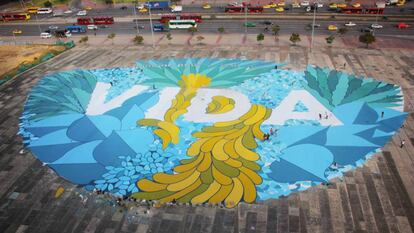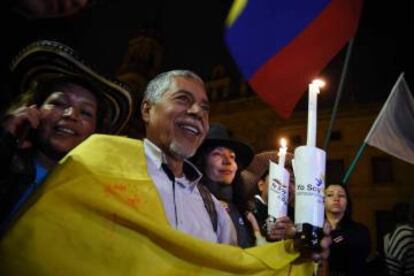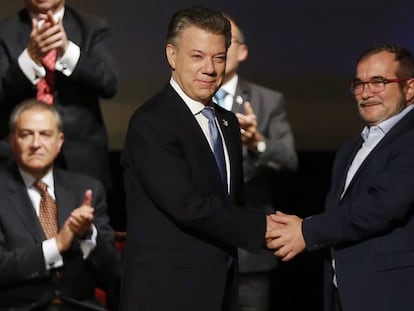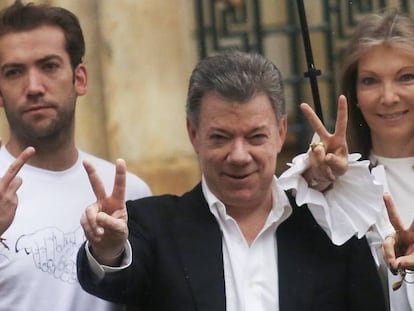How street art is bringing new life to Colombia
Spanish graffiti collective helps with Bogotá project for the social integration of relocated families
On November 24, the Colombian government and the FARC guerrillas signed off on a revised peace treaty, meant to end over 50 years of armed conflict in the country and pave the way for peace. As in any war, the consequences have been devastating: deaths, kidnappings and thousands of displaced persons, chiefly from rural to urban areas.

Aidel Yaguara, who was displaced by the guerrillas, defines it aptly: “Unfortunately we were forced to come and lead a life that we had no idea about. And it’s been a struggle, because it is not easy to adapt to a different environment and to a new situation.”
Faced with this reality, the city of Bogotá and Habitat, the United Nations human settlement program, are developing various projects to find these families a new home.
One of the most recent initiatives is Plaza de Hoja, located in central Bogotá, where 457 families are now living in subsidized homes.
The word ‘life’ seemed the most appropriate one since these people have been evicted from their places of origin
Pablo Purone, artist
But the goal of these policies goes beyond mere resettlement: they are also aimed at social integration for a group of people who often suffer from stigmatization.
And to that end, program developers have resorted to the most powerful weapon of all in their view – art.
The point is to give the surrounding area an identity of its own that will create a sense of belonging among its dwellers. And there is a second goal: to create a common task for all residents to work on together, as a way to reinforce social ties.
“What we seek through art is for people who are coming from a background of various conflicts to start finding common paths to walk down together,” says Jhon Zuluaga, of Hábitat.

Spanish artists
Boa Mistura, a collective of Spanish graffiti artists, was tasked with heading the project. The group has 15 years’ experience creating murals all over the world, from South Africa to Brazil, Britain, Norway, Serbia and India.They view their work as a transformational tool to change the look of streets and to create links between people.
“With very little time and money, painting manages to change one’s surroundings and creates new social relations, leading to a sense of empowerment,” says Pablo Purone, a member of Boa Mistura. Their working methods are always similar, and oriented at getting the community to participate as much as possible.
For the first few days, the artists live with the residents in order to understand their problems from within. Later, they conceptualize the information into a work of art that all locals are asked to participate in making.
In the case of Bogotá, the artwork occupies over 5,000 m2 and depicts a giant leaf made up of hundreds of smaller leaves set in such a way as to make out the word VIDA (life, in Spanish). The leaves belong to the most significant plant species to be found in Colombia’s various ecosystems, creating a parallel with the different people who live inside the building and their own diverse origins.
“The word ‘life’ seemed the most appropriate one, since these people have been evicted from their places of origin and brought here to start a new life where political problems and guerrilla violence have disappeared, to make way for a fresh start and to begin something new,” says Pablo Purone.
The painting is on the ground, and the sense of it is completely different depending on whether one walks over it or views it from above through a building window.
At ground level, all one sees is enormous geometric shapes in different colors, but from above eveything falls into place, representing a new beginning filled with hope – the kind of hope that an entire country is now longing for, the kind of hope that would bring “life” to Colombia.
English version by Susana Urra.
Tu suscripción se está usando en otro dispositivo
¿Quieres añadir otro usuario a tu suscripción?
Si continúas leyendo en este dispositivo, no se podrá leer en el otro.
FlechaTu suscripción se está usando en otro dispositivo y solo puedes acceder a EL PAÍS desde un dispositivo a la vez.
Si quieres compartir tu cuenta, cambia tu suscripción a la modalidad Premium, así podrás añadir otro usuario. Cada uno accederá con su propia cuenta de email, lo que os permitirá personalizar vuestra experiencia en EL PAÍS.
¿Tienes una suscripción de empresa? Accede aquí para contratar más cuentas.
En el caso de no saber quién está usando tu cuenta, te recomendamos cambiar tu contraseña aquí.
Si decides continuar compartiendo tu cuenta, este mensaje se mostrará en tu dispositivo y en el de la otra persona que está usando tu cuenta de forma indefinida, afectando a tu experiencia de lectura. Puedes consultar aquí los términos y condiciones de la suscripción digital.
More information
Archived In
Últimas noticias
From Andorra to Gibraltar, a black market for Ozempic exploits its success: ‘They’re the most sought-after products in the world’
Magnets in their heads: How some animals guide themselves using the Earth’s magnetic field
From Hungary’s Orbán to Chile’s Kast: How Trump helps turbo charge the far right
The brief rise and retreat of Generation Z in Mexico
Most viewed
- Why we lost the habit of sleeping in two segments and how that changed our sense of time
- Trump’s obsession with putting his name on everything is unprecedented in the United States
- Charles Dubouloz, mountaineering star, retires at 36 with a farewell tour inspired by Walter Bonatti
- The Florida Keys tourist paradise is besieged by immigration agents: ‘We’ve never seen anything like this’
- Living in a motorhome due to soaring housing prices in Madrid: ‘I got used to it quickly, but I don’t idealize it’










































